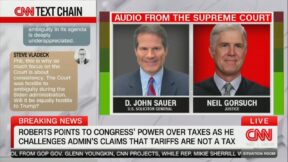WATCH: Reporter Asks Biden To Answer Critics Who Say He Was ‘Too Soft On Border Security And Now Too Hard’
Associated Press White House correspondent Colleen Long asked President Joe Biden to respond to criticism he was “too soft on border security” before his latest actions — but “now too hard.”
Fox News has long clamored for Biden to visit the border, leading an intense media charge that finally yielded results when President Biden announced new border enforcement actions last week and visited the border on Sunday in El Paso, Texas.
But those new actions have been met with criticism from advocates and activists that one reporter — New York Times White House correspondent Michael Shear — says exceeds anything he saw “during the Trump years.”
During a joint press conference Tuesday, Long asked the president to respond to the range of criticism, and Biden addressed the issue at length, saying neither sets of critics are correct:
PRESIDENT BIDEN: All right. I was having trouble hearing, but I’d like to call on Associated Press, Colleen Long, for the first question.
COLLEEN LONG: Thanks, Mr. President. Hola, Señor. And hi, Prime Minister Trudeau.
For Mr. President, you’ve been accused of being too soft on border security and now too hard, following the recent border policy changes. What’s the right balance?
(President Biden answers second question about classified documents)
PRESIDENT BIDEN: The first question, now I forgot. (Laughter.) Your first question related to —
COLLEEN LONG: I — yes, I asked if we — I asked if the —
PRESIDENT BIDEN: I’m only joking.
COLLEEN LONG: Oh. (Laughs.)
PRESIDENT BIDEN: The answer is — the answer is: You’ve got both — both the extremes are wrong. It’s a basic middle proposition.
Now, look, as was mentioned by all of us in one way or another, this has been the greatest migration in human history around the world, as well as in this hemisphere. And when I got elected, the first thing I — the first major piece of legislation I introduced was to reform the immigration process, to make it more orderly, to make it more — to make sure people have access under the law.
And so, what we found out — and not just in my visit to El Paso, but before that — we found out is that our Republican friends and some — a few Democrats — they were very critical of what’s going on at the border but yet refuse even look at the detail document I submitted for the Congress to consider to reform the process completely.
And so, number one, right now, a majority of our migrants are coming from four countries: Venezuela, Cuba, Haiti, and Nicaragua. And we’re expanding the exi- — the very successful parole program we had, with regard to Venezuela, to Cuba and to Nicaragua and to Haiti to provide safe and orderly and humane processing for people fleeing those countries to come to the United States and claiming under the — seeking asylum.
This is going to reduce the number of people legally trying to cross — illegally trying to cross the border. Venezuelans were trying to enter the country. That they dropped — that has dropped off dramatically because we’ve allowed them to go directly to whatever country — the first country they go to, directly contact the United States, make sure that they make their application showing that they have — they do a background check; they, in fact, have access to a sponsor; and that they have been — they’ve been examined. And that way, they’re able to come through ports of entry.
And it’s dropped off — I’m going to make sure I get the numbers right — dramatically from 1,100 persons trying to enter to — per day — to 250 a day.
I’ve asked the — and I want to thank the President of Mexico for agreeing to take up to 3,000 people back in — as — that don’t meet this criteria. Because, look, right now the cartels make a lot of money, which they use for drug trafficking as well. People go through — have to make it through jungles and a long journey to the — to the — to the border. And many are victimized, not only in terms of what they have to pay, but victimized physically in other ways.
And so we’re trying to make it easier for people to get here, opening up the capacity to get here, but not have them go through that godawful process.
And we’re going to continue our efforts to address the root causes of migration to help people stay in their home countries. I’ve asked the Congress for $4 billion to provide for that. We’ve also had our Vice President provide for private donations of over $3 billion to make sure that people —
Look, all of you know all of us in the United States are immigrants. And mine go all the way back to the Irish famine. But the point is: All of us have been immigrants. And one of the things that comes across fairly clearly is, it’s not like people sit in their home city, county, town and say, “I got a great idea. Let’s sell everything we have, give it to a coyote, go through some jungles and a long path up to the United States, smuggle us across the border, drop us in a desert. And won’t that be fun in a country we don’t even speak the language?”
We have — we can do more than merely just make legal immigration more streamlined. But we can also do it by preventing people from wanting to have to leave in the first place, by helping their communities, in fact, better their circumstances.
And so, I — I hope — you know, and, by the way, my proposals are supported by the Chamber of Commerce, by the American labor movement, not — I mean, which is an unusual coalition — and a whole range of people.
The point here is that my Republican friends in Congress should join us in the solutions.
And the one last point I’ll make — and I’m sorry to go on so long, but we spent a lot of time talking about it — is we have to increase the technological capabilities at the border, both to intercept illegal drugs and other contraband, as well as people being smuggled across the border.
We have now the ability to use and use — some of you have seen them; I know you all — you have, I’m sure — these trucks that ride alongside of a tractor trailer. It’s like a giant X-ray machine, and it can determine what’s inside that tractor trailer. And thousands cross the border every day — illegal commerce. And so, we’re allowed to determine whether or not there — fentanyl is in there, drugs in there, people being smuggled across the border.
We’re going to provide significantly more of those vehicles for the people to be able to determine at the border what need — what — what is coming across legally and illegally.
A lot more to say, but I probably already said too much. Thank you.
Watch above via C-SPAN.




